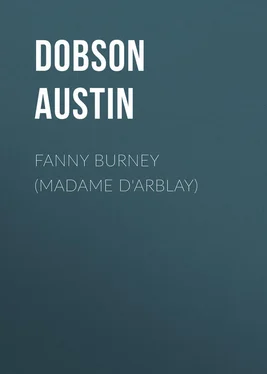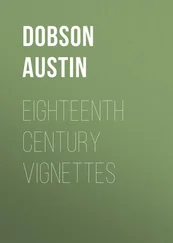Austin Dobson - Fanny Burney (Madame D'Arblay)
Здесь есть возможность читать онлайн «Austin Dobson - Fanny Burney (Madame D'Arblay)» — ознакомительный отрывок электронной книги совершенно бесплатно, а после прочтения отрывка купить полную версию. В некоторых случаях можно слушать аудио, скачать через торрент в формате fb2 и присутствует краткое содержание. Издательство: Иностранный паблик, Жанр: foreign_antique, foreign_prose, на английском языке. Описание произведения, (предисловие) а так же отзывы посетителей доступны на портале библиотеки ЛибКат.
- Название:Fanny Burney (Madame D'Arblay)
- Автор:
- Издательство:Иностранный паблик
- Жанр:
- Год:неизвестен
- ISBN:нет данных
- Рейтинг книги:5 / 5. Голосов: 1
-
Избранное:Добавить в избранное
- Отзывы:
-
Ваша оценка:
- 100
- 1
- 2
- 3
- 4
- 5
Fanny Burney (Madame D'Arblay): краткое содержание, описание и аннотация
Предлагаем к чтению аннотацию, описание, краткое содержание или предисловие (зависит от того, что написал сам автор книги «Fanny Burney (Madame D'Arblay)»). Если вы не нашли необходимую информацию о книге — напишите в комментариях, мы постараемся отыскать её.
Fanny Burney (Madame D'Arblay) — читать онлайн ознакомительный отрывок
Ниже представлен текст книги, разбитый по страницам. Система сохранения места последней прочитанной страницы, позволяет с удобством читать онлайн бесплатно книгу «Fanny Burney (Madame D'Arblay)», без необходимости каждый раз заново искать на чём Вы остановились. Поставьте закладку, и сможете в любой момент перейти на страницу, на которой закончили чтение.
Интервал:
Закладка:
CHAPTER II
NO. 1, ST. MARTIN’S STREET
No. 1, St. Martin’s Street, now No. 35, to which the Burneys moved early in 1774, may fairly be described as a house with a history. We say “now,” since it still exists, – standing to the right at the top of the little street which opens into Leicester Square from the south; and having on its left that Orange Street Congregational Church where, in its Huguenot days, was wont to preach Wesley’s opponent, – the Rev. Augustus Montague Toplady. The house itself, once red brick, but at present stuccoed over, is not impressive, save for the distinction conferred by a Society of Arts tablet which proclaims it to have been formerly the residence of Newton. Miss Burney, indeed, as her father supposed, declares that Sir Isaac built it; but this is an error. He took it in 1710, when he was nearing seventy, and he lived in it until 1725, two years before he died at Kensington. Beyond occasional visits to the Princess Caroline at Leicester House on the opposite side of the Fields; and the fact that he superintended the production of two editions of the Principia during his period of residence, no very definite traditions belong to his sojourn in St. Martin’s Street. But Dr. Burney, who valued literary association, had a better reason for connecting his new house with Swift, than he had for connecting him with Queen Square. For in Newton’s house in St. Martin’s Street had certainly dwelt one of Swift’s intimates and Newton’s relatives, the beautiful and witty Catherine Barton, – the “ jolie nièce ” of Voltaire, – and the “Super-intendant of his domestick Affairs” to Charles Montagu, Earl of Halifax, to whom, it is conjectured, she was privately married. After the death of Halifax in 1715, she became the wife of John Conduitt, Newton’s successor as Master of the Mint; and, when in town, was accustomed to reside with her uncle in Leicester Fields. And it is no great stretch of imagination to assume that, at such times, though Swift himself was in exile, she was visited by the other old friends who had clustered around her when she was a Toast of the Kit Cats. The chairs of Lady Worsley and Lady Betty Germaine must often have waited at the narrow approach by which the street was then entered from the Fields, while their mistresses “disputed Whig and Tory” with Mrs. Conduitt, or were interrupted in a tête-à-tête by Gay and the Duchess of Queensberry. 12 12 Catherine Hyde was still living in Fanny Burney’s day; and Fanny saw her at Covent Garden Theatre in January, 1773, when Mason’s Elfrida was being acted. “I had the pleasure to see Prior’s celebrated fair ‘Kitty, beautiful and young,’ now called Kitty, beautiful and old , in the stage box.” ( Early Diary , 1889, i. p. 184.)
As regards situation, the change from Queen Square to St. Martin’s Street was not entirely for the better. It was no small loss to substitute an “unpleasant site,” “confined air,” and a “shabby immediate neighbourhood” for the unobstructed view of “Hampstead’s breezy Heath” which the Bloomsbury home afforded. 13 13 “There are now,” said Cunningham, writing as far back as 1849, “at least 2 square miles of brick and mortar between it [Queen Square] and the view.” ( Handbook for London , ii. p. 686.)
But in the way of convenience, and a central position, the difference was great, in addition to which, compared with its predecessor, the new residence was “large and good.” It is true that the stairs were so steep and narrow that one of Fulke Greville’s friends broke his sword in climbing them; but, on the other hand, most of the rooms were panelled, and one, at least, of the ceilings “prodigiously painted and ornamented,” not, as the Doctor was careful to explain, by him, but by previous occupants. The chief glory of the house, however, was the unpretentious structure at the top, which passed for Sir Isaac’s observatory. It is perhaps safest to say “passed,” because, between 1725 and 1774, there must have been other dwellers in No. 1, St. Martin’s Street, and many things may have happened. But the Burneys seem to have devoutly believed in the small-paned, wooden turret, with the leaden roof and tiny fireplace, which embodied so respectable a tradition. They exhibited it religiously to their visitors; and one of its new owner’s first acts was to put it into repair. When, four years later, it was all but whirled away by the hurricane of 1778, he practically rebuilt it. And it was unquestionably Fanny’s chosen retreat and scriptorium . “His [Newton’s] observatory is my favourite sitting place, where I can retire to read or write any of my private fancies or vagaries.” And then follows what – having regard to some of her previous utterances – is more interesting than unexpected. 14 14 See ante , p. 19.
“I burnt all up to my fifteenth year – thinking I grew too old for scribbling nonsense, but as I am less young, I grow, I fear, less wise, for I cannot any longer resist what I find to be irresistible, the pleasure of popping down my thoughts from time to time upon paper.”
Whatever may have been her exact age at the date of the famous auto-da-fé in the paved court at Poland Street, she must have been nearing two and twenty when she “popped down” the foregoing passage; and the moment, taken in connection with the change of scene from Bloomsbury to Leicester Fields is a favourable one for reviewing the Burney family circle in 1774-5. Dr. Burney’s second or German Tour, as we know, had been published in 1773; and in the same year he had been made a Fellow of the Royal Society. At present, in the intervals of rheumatism, he was working, with Fanny’s aid, at his History of Music . By his second wife he had two children, – Richard, and Sarah Harriet, the latter of whom eventually, like her gifted half-sister, became a novelist. But both Richard and Harriet, at this date, were in the nursery. Esther, or Hetty, the eldest daughter, had been married for some time to her cousin, Charles Rousseau Burney, afterwards of Bath, a musician and former pupil of her father; while Maria Allen, the daughter of Dr. Burney’s second wife, was married to a Mr. Rishton. James Burney, the sailor, having sailed with Cook in his second voyage, and been made a lieutenant, had now returned home. In 1775 he was serving on the North American Station, when he was recalled to accompany Cook on his third and fatal expedition. Of the rest, Susan and Charlotte were now grown up, Charlotte being about fifteen, and Susan some years older. Charles, after having enjoyed the reputation of being “the sweetest-tempered boy in the Charterhouse School,” was now, in all probability, pursuing at Cambridge those studies for which he was eventually to be classed with Porson and Parr. The only one of the Queen Square frequenters no longer to be encountered at St. Martin’s Street was “Daddy” Crisp. By this date he was sixty-eight, and his fits of gout had become so severe, that he had ceased to make his annual descents upon London from his Surrey hermitage. But his interest in all that befell his friends at Leicester Fields remained unabated; and in this he was kept carefully posted up by his favourite “Fannikin,” who, what with acting as librarian and amanuensis to her indefatigable father, writing periodical news-letters of “from six to twelve large quarto pages” to Chessington, and keeping her own voluminous journal besides – must have been very actively employed both in the Observatory and out of it. Not without reason can it have been that she acquired the “murtherous stooping” which her Mentor deplored, nor was it entirely chargeable to the shortness of sight which she shared with Charlotte Brontë. It is from her bright and graphic despatches to Mr. Crisp that we propose to draw most of the material for this chapter. Often these are repeated in her Diary , and they are also expanded in the Memoirs of Dr. Burney which she wrote in later years; but they are at their best and freshest in her letters, – letters which, in many cases, must have been scribbled off immediately after the occurrence of the events they described. From one of them it is clear that their writer thought nothing of setting to work at what would now be considered a very lengthy epistle, when the entertainment of the evening had come to an end.
Читать дальшеИнтервал:
Закладка:
Похожие книги на «Fanny Burney (Madame D'Arblay)»
Представляем Вашему вниманию похожие книги на «Fanny Burney (Madame D'Arblay)» списком для выбора. Мы отобрали схожую по названию и смыслу литературу в надежде предоставить читателям больше вариантов отыскать новые, интересные, ещё непрочитанные произведения.
Обсуждение, отзывы о книге «Fanny Burney (Madame D'Arblay)» и просто собственные мнения читателей. Оставьте ваши комментарии, напишите, что Вы думаете о произведении, его смысле или главных героях. Укажите что конкретно понравилось, а что нет, и почему Вы так считаете.












